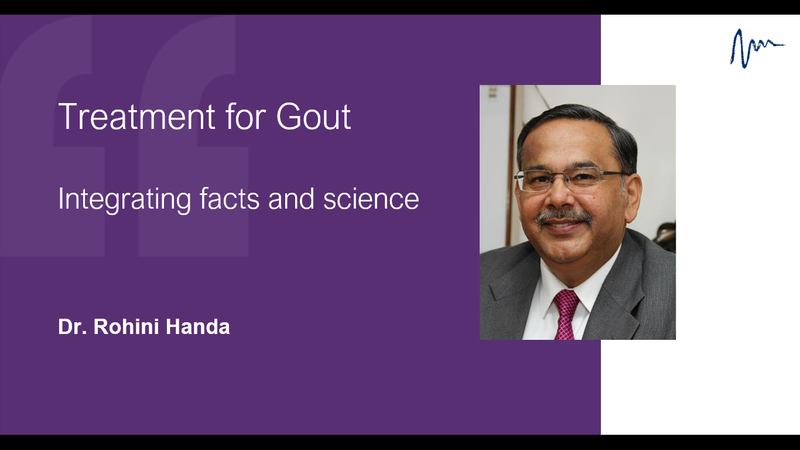Gout:Treatment-Facts and science -Dr. Rohini Handa
M3 India Newsdesk Jun 20, 2018
Here Dr. Rohini Handa, eminent rheumatologist throws light on the treatment of Gout.

In this 2 part series, Dr. Rohini Handa, a noted Rheumatologist takes us on an interesting journey of 'Gout- the oldest type of inflammatory arthritis', detailing on its history, associated myths, and discussing modern-day treatment on the way.
The clinical presentation and diagnosis of Gout, pointers by Dr. Rohini Handa. Read it here
Treating Gout
The drug treatment of gout has 3 facets:
- Treatment of an acute attack
- Prevention of further attacks
- Treatment of hyperuricemia
Physical modalities helpful during acute attack include rest, elevation and ice packs. NSAIDs are the treatment of choice for acute attacks of gout. Corticosteroids may be used in patients with contraindications to the use of NSAIDs e.g. renal failure or congestive cardiac failure. Oral prednisolone 20-40 mg daily tapered over 2 weeks or intra-muscular methyl prednisolone 40-120 mg may be used.
There is no consensus on agent, dose or route of administration. Intraarticular corticosteroids are extremely effective in acute gout. Allopurinol should not be started during an acute attack of gout as it may precipitate another attack or prolong the duration. Patients already on allopurinol should continue the drug.
Key considerations in the treatment of Gout
- Allopurinol should never be instituted or discontinued during an acute attack of gout
- Acute attack: Treatment of choice NSAIDs. In situations where NSAIDs are contraindicated colchicine or corticosteroids may be used.
- Colchicine in lower doses is equally effective but far better tolerated
- Currently, the main role for colchicine is in the prophylaxis of recurrent attacks (>2-3 attacks/year)
- Target of treatment in gout is SUA <5.5 mg/dl
- Restricting allopurinol dose to 300 mg/day sub-optimally controls gout in a substantial number of patients. The dose ranges from 100-800 mg per day.
- Febuxostat is metabolized primarily by the liver. It is the preferred urate-lowering treatment in renal insufficiency.
- Allopurinol is preferred over febuxostat in patients with liver disease. The dose of allopurinol needs to be reduced in renal insufficiency.
- Drug combinations in Gout: Combining allopurinol with febuxostat is not recommended. Uricosurics can be combined with xanthine oxidase inhibitors.
- Duration of treatment with urate-lowering therapies is lifelong. Treating acute attacks only is like treating tip of an iceberg.
- In transplant patients remember allopurinol azathioprine interaction. Allopurinol inhibits xanthine oxidase, the enzyme which metabolises azathioprine. This can lead to marked reduction in the WBC count.
- Adherence is a major issue in gout
Patients with recurrent attacks (>3 per year) may be advised colchicine prophylaxis (0.5 mg twice daily) for 6 to 12 months in addition to allopurinol. Available urate-lowering medications include the xanthine oxidase (XO) inhibitors allopurinol and febuxostat. Uricosuric drugs include the urate transporter 1 (URAT1) inhibitors benzbromarone and probenecid.
Uricase enzyme pegloticase is used for severe, tophaceous gout. Lesinurad is a recently approved selective uric acid reabsorption inhibitor. Approved dose is 200 mg once daily in combination with XO inhibitors. Pro-inflammatory cytokines like interleukin-1 (IL-1) are also being targeted in new drug development programmes. Agents include the IL-1 receptor antagonist anakinra and rilonacept (also called IL1 Trap).
New treatments
An exciting new drug on the horizon is arhalofenate, an anti-inflammatory uricosuric drug that reduces the risk of gout flares while also lowering SUA. It is the only drug that does not increase the risk of flares when lowering SUA. By its dual benefit action, it decreases the incidence, duration, and severity of flares while lowering SUA. Other benefits of arhalofenate include improvements in insulin sensitivity, as well as reductions in serum glucose, triglycerides, and markers of inflammation.
Aging of populations, lifestyle changes, co-morbidities, poor adherence and drug interactions are some of the factors contributing to the increasing prevalence of gout and the current complexities in its management. Lesinurad is an important addition to the therapeutic armamentarium. Arhalofenate and IL-1 modulation represent potential new treatments that may address the unmet needs in gout management.
The clinical presentation and diagnosis of Gout, pointers by Dr. Rohini Handa. . Read it here.
Disclaimer- The views and opinions expressed in this article are those of the author's and do not necessarily reflect the official policy or position of M3 India.
-
Exclusive Write-ups & Webinars by KOLs
-
Daily Quiz by specialty
-
Paid Market Research Surveys
-
Case discussions, News & Journals' summaries